This article is written by Sourav Ghosh, iPleaders’ Digital Marketing Consultant; who has 10+ years of experience in MLM industry as a Distributor and an Educator. Sourav runs a Facebook group MLM Eye Opener, teaching distributors from various MLM companies unbiased generic industry education.
Keep it saved
Index
What is MLM?
MLM or ‘Multi-level Marketing’ is also known as Network Marketing / Direct Selling / Social Selling / Referral Marketing in different marketing cultures across the globe.
MLM or ‘Multi-level Marketing’ is an alternate form of distributing products and services.
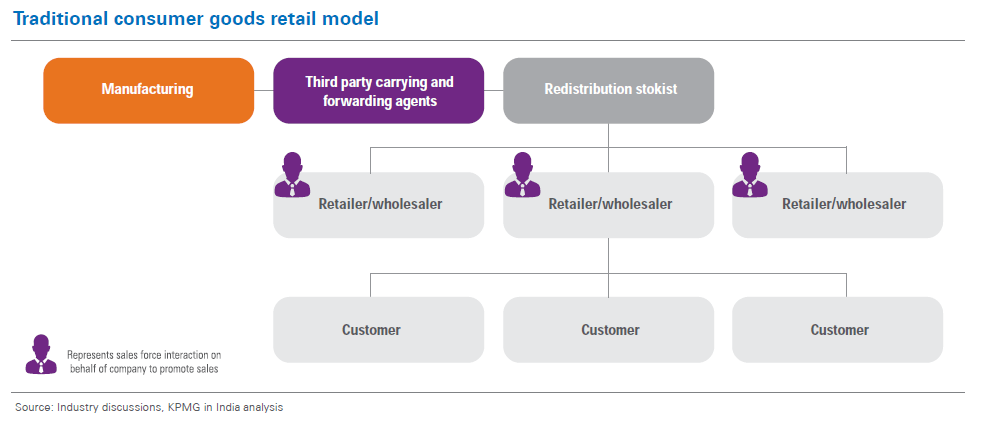
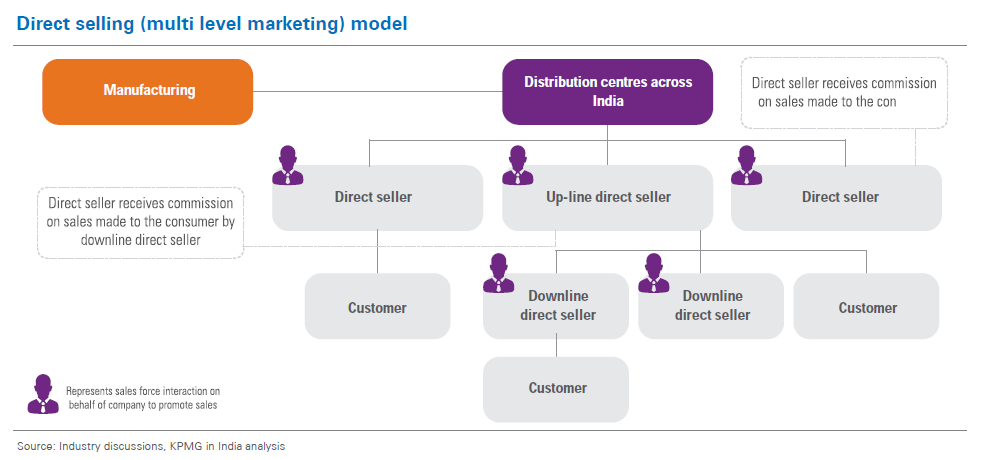
Image Source: FICCI Direct Selling Report 2015
Instead of using the traditional distribution channel (Distributor – Retailers – Consumers), MLM companies sell their products & services directly to consumers using ‘word-of-mouth’ referrals from existing consumers. That’s why it’s called Direct Selling.
As a happy customer/consumer in an MLM company, you are given opportunity to become a distributor and earn retail commission for the sales generated by your referrals. Now your customers might like the products/services & decide to become distributors. When distributors referred by you refer other customers, they earn retail commissions & you earn team commission or group commission according to the total sales generated by your Network of distributors.
Every MLM distributor can earn retail commission for the sales generated by personal referrals & team commission for the sales generated by multiple levels of distributors in their network, according to the compensation plan of the company.
Contrary to common misconception, you are not paid to recruit people, you are paid depending on the total sales volume generated by your entire team. Instead of spending money on traditional advertisements & other marketing methods, Direct Selling companies rewards their consumers turned distributors for their word of mouth advertisement effort.
Is MLM Legal or Illegal?
Whether MLM is legal or not, is a Global confusion. There are people who believe that every MLM is some kind of illegal pyramid scheme and there are people who literally worship this industry.
To give you a rational perspective, neither all Direct Selling / MLM / Network Marketing are illegal nor every company claiming to be another revolutionary MLM is legitimate. Even in legitimate MLM companies, unfair trade practices & exaggerated misrepresentations by certain distributors makes this industry so controversial.
Amway Safeguard Rule
In 1975, the FTC accused Amway of operating as an illegal pyramid. After four years of litigation, in 1979, Amway prevailed. An administrative law judge ruled that Amway’s multilevel marketing program was a legitimate business opportunity as opposed to a pyramid scheme. In case you want to study, here is the complete legal document for the case.
This decision has become known as the “Amway Safeguards Rule,” which is currently one of the most significant sets of legal standards by which courts and regulatory agencies determine the legitimacy of an MLM/network marketing/direct sales company.
Legitimate MLM Company vs Illegal Pyramid Scheme
Let us help you to differentiate between a legitimate MLM company and an illegal pyramid scheme.
-
-
- If the business plan focuses on rewarding participants for recruiting rather than for selling products/services to the end customer, then it’s illegal.
- If any distributor makes money from things other than selling products/services (personally + group volume), then it’s illegal. Earning from event tickets, earning from selling training materials etc are illegal.
- Legitimate Direct Selling companies don’t require large upfront investment or buying a large quantity of inventory.
- Any program offering big money but claiming “no selling required” is illegal.
- Products or services provided by Direct Selling company must be a legitimate one, that people would buy at the retail price at the open market (without participating in the compensation plan).
- If the direct selling company distributes health and wellness products, no miraculous claims (like our products cure cancer) must be made without being approved by the medical association.
-
Avoid Scams and Report Scams
Check this searchable database of scams & unviable business models prepared by Strategy India. I will strongly advise against participating in the companies listed here. You can also report a scam if that is not already listed there. My friends at Strategy India will investigate and update the list.
Negative Press vs Positive Praise
There are certain significant figures like Billionaire Hedge Fund manager Bill Ackman & popular comedian talk show host John Oliver, who went too far to trash the concept of MLM.

On December 19, 2012 CNBC’s Kate Kelly reported that Bill Ackman’s hedge fund has taken a massive short position – about $1 Billion worth, in a nutrition company called Herbalife (It’s a 37-year-old, 8,000-employee nutrition company that sells 5,300 products in 91 countries via MLM, including weight-loss powders, vitamins, performance sports drinks, and a skin-care line).
Next day, Ackman presented a “public short” ( A public short is a risky, fairly rare phenomenon in which an investor not only bets on a stock to go down—known as short-selling—but publicly announces that he has done so, explaining why) calling Herbalife the “best-managed pyramid scheme in the history of the world”. He expected the stock not just to decline but to go to zero, he made clear. If his bet paid off, he’d donate his personal profits to charity, because he considered any proceeds from a corporation so villainous to be “blood money.”
Naturally, Herbalife retaliated and other billionaire Investors like Carl Icahn stood by the company buying more shares of it. Over last 5 years, this battle is continuing. Both parties are accused of playing dirty. You can read more details about it in this massive Fortune magazine article – The Siege of Herbalife.
The latest development is a documentary Betting on Zero that is claiming to expose Herbalife as an evil pyramid scheme and Bill Ackman as a righteous savior.
But a website www.bettingonzero.com, probably created by Herbalife, tells you another side of the story.
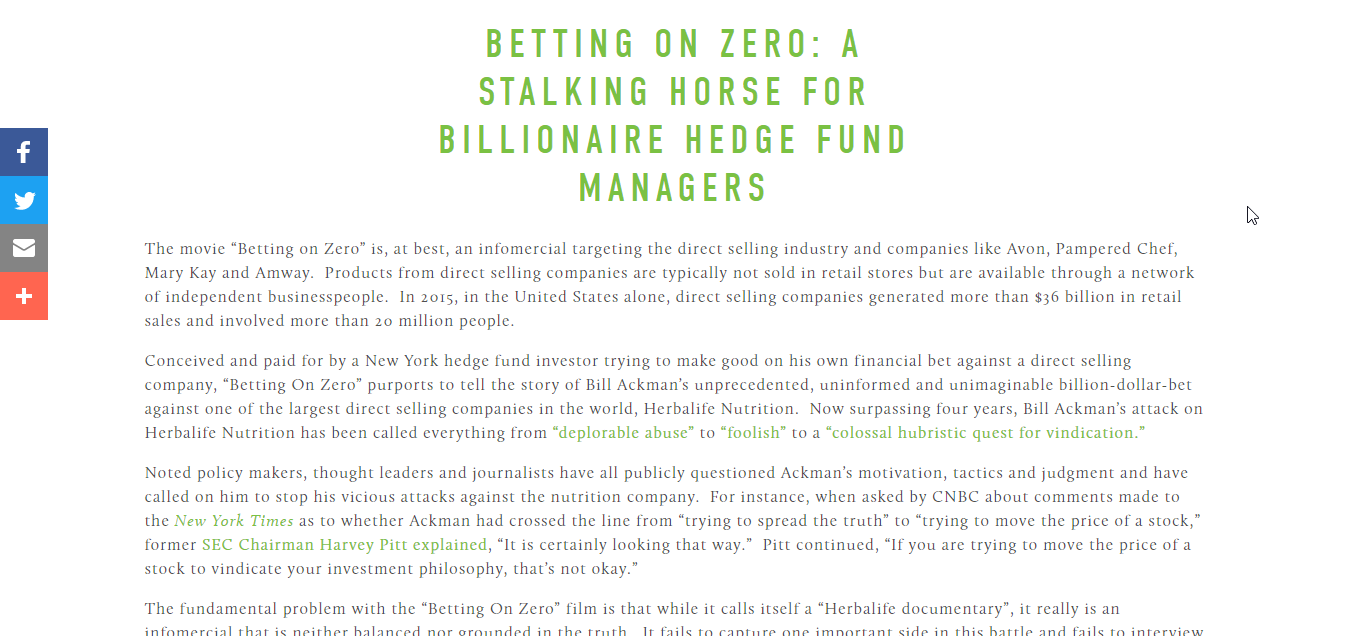
Though the stock market didn’t follow Ackman’s prediction …
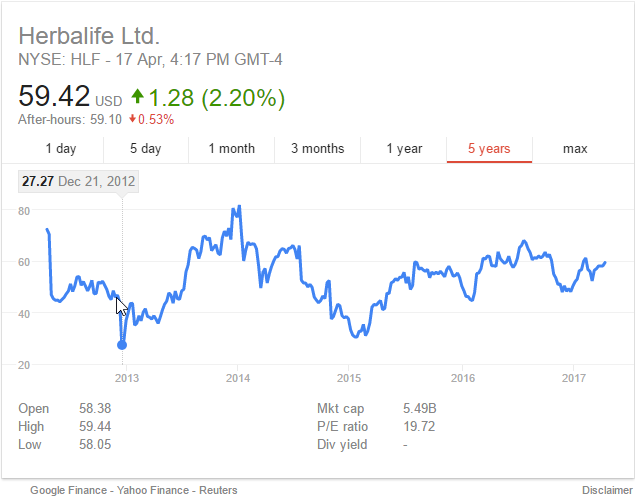
… Herbalife had to pay $200 fine to settle FTC charges, due to some unfair trade practices. Read complete details in the Facebook post below.
https://www.facebook.com/souravghoshofficial/photos/a.495760623879603.1073741828.495656280556704/926611717461156/?type=3
So we can safely say that Herbalife is not an illegal pyramid scheme but had some unfair trade practices that they had to change and pay fine for.
Now let me show you John Oliver’s funny and damaging take on MLM
Though I agree with some of the issues raised by John, like ‘overhype’ in this industry etc; I expected a person like John to shed some light on positive aspects of this industry as well. But that didn’t happen.
Glad someone (outside MLM industry) decided to point that out and actually explained the MLM business model with all positives and negatives.
Grab the PDF accompanying the video above
In fact, there are many Global thought leaders who consider MLM / Direct Selling / Network Marketing as a very promising form of Entrepreneurship.
A documentary is made on this – Rise of the Entrepreneur.
https://youtu.be/dYx75VMgR8c
Global thought leaders are sharing their thoughts about this industry for ages
Understand this. Most of these thought leaders have their global reputation, that they wouldn’t risk endorsing an industry if it was not legitimate and promising.
And in case you didn’t know, top Global brands below distribute some or all their products through Direct Selling.
- Microsoft
- AT & T
- Gillette
- Colgate
- Citibank
- IBM
- Toyota
- Coca-cola
- Xerox
- Texas Instrument
- General Motors
- General Electric
- AOL
- Oracle
- Sun Microsystem
- Hindustan Unilever
If you are interested in more in-depth information regarding MLM Legality, read this article.
MLM / Direct Selling / Network Marketing in India
Now let’s discuss MLM in the context of our country – How old is MLM in India, how it evolved over years, current data and applicable laws.
How important India is for MLM / Direct Selling industry?
The current population of India is 1,339,357,345( ~ 1.33 Billion) as of Wednesday, 19th April 2017, based on the latest United Nations estimates. Which is 17.84% of the total world population. Like every other industry, Direct Selling industry is also aiming to capture a share of this huge human resource, both as customers & distributors. Many Global MLM / Direct Selling companies believe that India has the potential to give this industry an exponential growth.
From FMCG to electronic goods, India’s huge customer base is an ideal market for many MLM / Direct Selling companies.
History of MLM in India
MLM is not new in India. When I joined this industry in 2007 at the age of 19, I remember my Dad warning me giving an example of his friend who failed terribly in Amway.
Point being, MLM / Direct Selling has been in India for quite a long time (possibly from 90s) but very few people actually understood the business model & potential.
Early Perception
Either the shopkeepers were selling Amway, Oriflame, Avon products with their regular retail products to their customers. Or people with big dreams kept selling dreams to others promising ‘big money’ ‘easy money’ by recruiting, earning this industry a shady reputation of ‘member making scheme’.
Some people kept joining this industry, investing big money to stock their houses with more products than they’d ever use or have the skill to sell. As they were misled to believe that the products would sell themselves making them rich in a year/months/even days. Well when that false expectation bubble burst, most left this industry with scars taking a silent mission to save everyone else from ‘MLM Trap’.
To be very honest, the words ‘MLM’ or ‘Direct Selling’ or ‘Network Marketing’ were used very less. Our industry was better known as ‘Amway type business’ or ‘That business where you need to beg people to join you’. People started forming a perception about this industry from their friends, family or little-known acquaintances who were supposedly expert about this industry after failing terribly ( or should I say ‘after giving up too soon without learning what this industry was all about’?)
Rise of MLM / Direct Selling in India in Last Decade
Things started changing slowly in last decade. Young India was adopting technology, social media & turning into Entrepreneurship. MLM industry was also upgrading itself globally to improve its positioning, operations.
Some global MLM / Direct Selling company started doing great business in India. And then some top Indian leaders from those companies started their own Direct Selling companies here. Some failed terribly. But those who survived started doing business like wildfire.
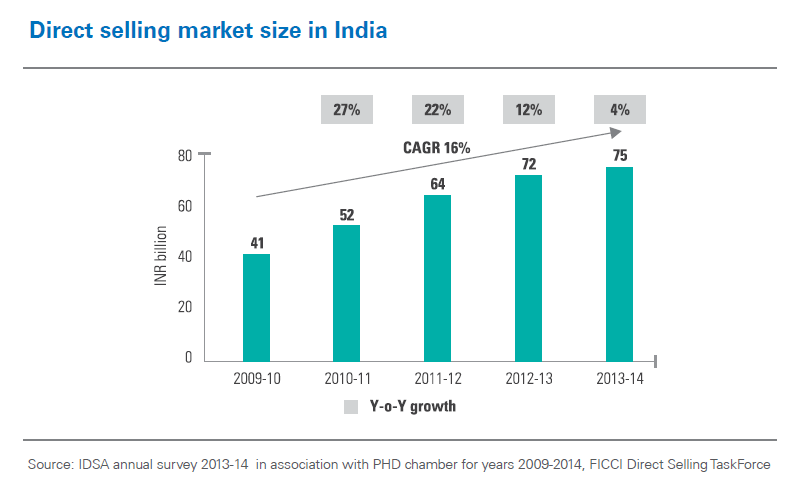
Let me quote from Direct 2015 – A Report on Indian Direct Selling Industry Published by FICCI and KPMG:
“The direct selling market in India has grown at a CAGR of 16 percent over the past five years to reach INR75 billion today. The market grew at a lower rate of 4 percent in 2013-14 due to a slowdown in the industry.
The Indian Direct Selling Industry is well placed to successfully foray into international and domestic markets. However, there are many issues and challenges that need to be overcome to make that vision a reality. The factors hampering full-fledged growth include: fly-by-night Ponzi and pyramid schemes which are often confused with direct selling, a clear legal definition of the industry, and clear and centralized regulations.
In states such as Andhra Pradesh, Telangana, and Kerala, the direct selling business has been impacted due to lack of regulatory clarity. There is a need for the central as well as respective state governments to arrive at a comprehensive policy for the industry, which would enable the industry to grow and create both direct and indirect employment.”
Overall Direct Selling industry started growing in India very fast. During this growth, there were legitimate companies & distributors running this business properly. But the earning potential gave birth to foul players who wanted to cash in this trend. New companies started popping up everywhere, either with copied products & business model or with some baseless products just to hide the true intention. These companies started chasing distributors from existing companies. Bought top leaders, lured entire teams to shift company promising a better return.
Lack of proper education about this industry led many distributors to fall into these traps & lose time, money & reputation. Most of these new companies fell apart within few years. And some of the old companies got too much damaged by this loss, to recover. Normal distributors & this industry suffered.
Even many distributors from legitimate companies started misrepresenting this business in flashy seminars & events, making big money promises, showing off their cars bought on EMI.
In an industry where the true benefits were incredible enough; too much exaggeration, lies, hype attracted unnecessary suspicions not only from rational common people but also from legal officials & Govt. regulators.
The fundamental principle of Direct Selling – ‘the commission paid is on the basis of total sales generated by you & your team’, was highly neglected & rarely talked about. The amount of effort needed by a person to learn the skills & actually sell the products, were tactfully omitted during the representation of this business. Entire focus on earning big money & enjoying luxury lifestyles by recruiting others raised red flags of ‘quick/easy money’ & ‘money circulation schemes’.
Hence started the phase where police & legal officials started going after big legitimate Direct Selling companies, whereas smaller illegal companies stayed under the radar fooling as many people as possible.
Around the country, police raided Direct Selling events, arrested distributors & company officials, filed cases against companies.
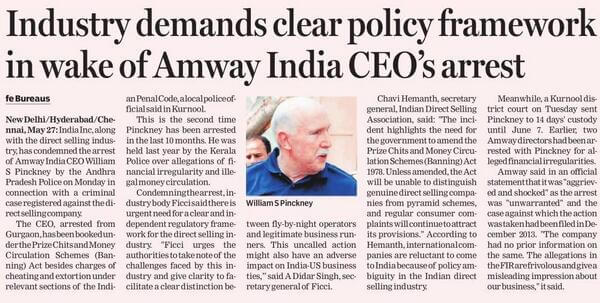
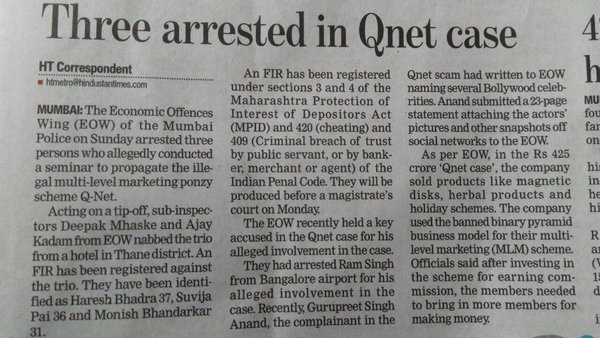
MLM Laws in India
Can’t blame them as India didn’t have any defined regulations for Direct Selling industry, more importantly, India didn’t have any clear official guidelines to differentiate between legitimate MLM / Direct Selling companies & illegal pyramid schemes.
All the legal actions against MLM / Direct Selling companies were being taken on the basis of Prize Chits & Money Circulation Schemes (Banning) Act 1978, which was enacted decade before Direct Selling concept came to India.
Let me share some highlights from PCMC act and why it continued to haunt our industry in India.
Prize Chits & Money Circulation Schemes (Banning) Act 1978 [ PCMC Act]
Prize chits & money circulation schemes were declared illegal in The Prize Chits and Money Circulation Schemes (Banning) Act, 1978 enacted on 12th December, 1978.
This PCMC act differentiated between Conventional Chits & ‘Prize Chits & Money Circulation Schemes’
Section 2(c) the PCMC Act defines “money circulation schemes” as:
… any scheme, by whatever name called, for the making of quick or easy money, or for the receipt of any money or valuable thing as the consideration for a promise to pay money, on any event or contingency relative or applicable to the enrolment of members into the scheme, whether or not such money or thing is derived from the entrance money of the members of such scheme or periodical subscriptions
Highlights from this complex documents with legal jargons
-
-
- Any person breaching this act & participating in such illegal schemes will face an imprisonment extending to three years or with fine extending to five thousand rupees or with both.
- Any person involved in any kind of activities related to such illegal schemes shall be punished with imprisonment which may extend to two years, or fine of rupees three thousand, or both.
- Any police officer with minimum rank of officer-in-charge of a police station or any officer appointed by State Government can enter any premises connected to such illegal schemes, by force if necessary. They can search & seize anything found there. Take the involved people into custody & present before Judicial Magistrate lodging a complaint.
- Any newspaper and publications containing PCMC schemes will be forfeited.
-
The clause “on any event or contingency relative or applicable to the enrolment of members etc” did not clarify for the special case of multi-level marketing models used by direct selling companies. That started all confusion.
For years MLM / Direct Selling companies, distributors, industry associations and industry advocates in India, kept requesting Indian Government to come up with a separate regulatory framework for this industry, that would protect consumers and legitimate companies while exposing scams.
Finally, that happened on 12th September 2016.
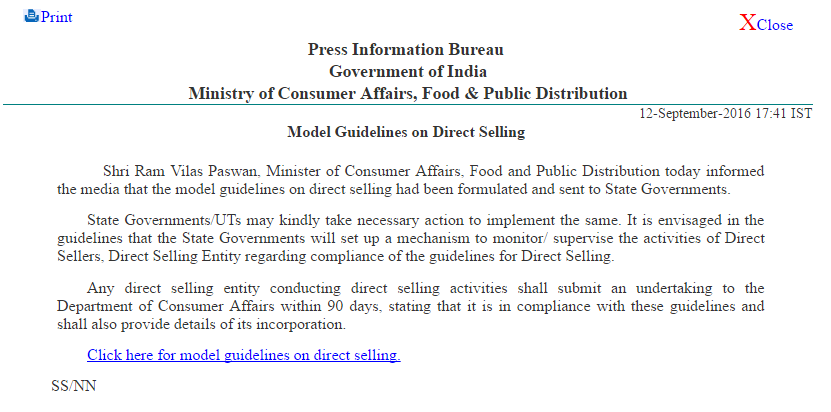
Direct Selling Guidelines 2016
Finally Shri Ram Vilas Paswan, Minister of Consumer Affairs, Food and Public Distribution; announced these Model guidelines on Direct Selling with a press release on Monday, 12th September 2016.
Let’s try to simplify the guidelines with a summary infographic
For complete text of the Guidelines and detailed analysis, read this post
Recently after Supreme court ordered a stay on the proceedings on Qnet, legitimate MLM companies are seeing ray of hope for doing business in India without unexpected legal hassles. Attaching an article from Business India magazine below.
Process of Starting & Structuring an MLM company
Before you dive into starting your own MLM company, I will strongly recommend reading this article from MLM Attorney Kevin Thompson – 33 Reasons NOT to Start an MLM
Most founders of new MLM companies, that vanish within few years, have no idea about what they are getting into!
And now numerous MLM software providers are convincing people that anyone can start and run their own MLM companies with their MLM software. Wish running an MLM company was that easier.
Assuming you are informed and confident about starting an MLM company in India, here are the basic requirements to structure a legal, permissible & sustainable Multi-level Marketing Company in India (borrowing experience of Direct Selling Consultation Firm Strategy India):
Company
-
-
- The company needs to be registered under Companies Act 2013 anywhere in India.
- It should be a direct selling Entity with acquired licences as per the law of the land where the business would prevail.
- The licences to be obtained are PAN number, TIN number, CIN Registration number, labour Licence and a bank account in a Nationalized Bank of India.
- The person starting a Multi-level Marketing Company should make the company’s status and structure clear by the way of MOA (Memorandum of Association) and/or in the partnership deed. Nature of business should be specified by the documents of the company.
- As per the requirement and the norms, the Company shall comply with all the applicable statutory formalities of central government, including Income tax, Service tax, Food Safety and Standards Act of India, etc. and also of respective state governments (VAT, CST, Trade license, Shops and establishments Act, etc.).
- Minimum net worth of the Promoters of the company should be INR 50,00,000 (Fifty lac Indian rupees) and its paid-up capital should be a minimum of INR 5,00,000 (Five lac Indian rupees)
- Company should clearly mention and formulate the rate of incentives and profits to be distributed to the independent contractors/down lines and also the time limit within which the company should pay their share of incentives.
- The company should have an official website which clearly shows its total information and even shows the names of the authorized direct sellers appointed by the Company and their Personal Identification Numbers.
- The Company should have an independent department handling the Consumer Grief within 7 days of such grievances get registered. Consumer Complaint registration should be easy and straightforward.
- A file should be maintained in the Company office (READY INFORMATION FILE) containing the following documents:
- Certificate issued by Registrar of Companies, Memorandum of Association (MoA), Articles of Association (AoA) and Management and Operations Memorandum (MoM);
- Copies of Taxpayer Identification Number (TIN), Director Identification Number (DIN) of Directors, Tax Deduction Account Number (TAN), and Permanent Account Number (PAN);
- Certificate of Sales Tax, Service Tax and CST Registrations;
- Copies of all Sales Tax Returns filed with the authorities;
- Copies of Service Tax Returns filed with the authorities;
- Copies of IT Returns of the company filed with the authorities;
- Tax Deducted at Source (TDS) Statements of Distributors and respective challans paid;
- Copy of the latest balance sheet, profit and loss account and reports of the auditors or directors of the applicant.
- Records of Know Your Customer (KYC) and Know Your Direct Sellers (KYDS), the formats of which should be available on the company website (password protected).
-
Products
-
-
- Price – MRP of the product/s should be clearly displayed on the package and the official website of the company. The company should give a notice of at least 30 days to all its active direct sellers before increasing/decreasing the price of any product.
- Tax – the company should pay the applicable tax at MRP (Maximum retail price).
- Satisfaction Guarantee – A Satisfaction Guarantee / Refund Policy of at least 30 days from invoicing of the product. This would be applicable if not more than 30% of the product is consumed in case of consumable products. The consumer should be refunded 100% (minus the taxes) of the amount collected against the product by the direct seller. In case of non-consumable products, the product may only be returned if in marketable condition. The consumer should also be given an opportunity to exchange the goods within 30 days if they find any manufacturing defect or the product is not useful for the purpose it was meant.
- Money back Guarantee – A money back guarantee of 30 days from invoicing of the product. This would be applicable to all products returned in marketable condition. The direct sellers should be refunded 100% (minus the taxes) of the invoiced amount.
- Service support – for products promoted by the company is the responsibility of the company.
- Non delivery of product/s – On non-delivery of the products / services to the direct seller within 20 days of invoicing (after the receipt of the payment by the company), the company, on request by the direct seller via email or post, will refund the entire amount paid by the direct seller by cheque / demand draft / pay order / reverse transaction within 7 working days of receiving the request.
- Product Claims – all the claims made by the company (on the official website and literature, including brochures, packaging, and labels) for the products should be supported by evidence in the form of certifications from competent authorities (e.g., laboratories).
- The laws applicable on the category of products in India would apply (Sale of Goods Act. 1930, etc.).
- Negative list: (not to be promoted by companies deploying direct, single level and multilevel marketing compensation plans):
- Deposits / Investments – in / for / in the form of – Stocks, Shares/I.P. O, Debentures, Currencies, bullion markets, Preferential shares, Forex Trading, Plantations, Farming, Infrastructure projects, Resorts, Trading in commodities, Birds (Poultry, Emu, Quail, etc.), Livestock (Rabbit, Goat, Sheep, Cow, Buffalo, etc.), Media, Car Lease and Real Estate.
- Crowd funding ventures
- Discount coupons / Vouchers / Currency
- Betting / Gambling activities
- Quiz portals
- Recharge portals
- Peer to Peer transactions in any names as Support, Gift, Help, Assistance, Donations, etc.
- Bid coupons / Vouchers
- Websites / Web space / Bidding portals
- Buy in to get paid- to click, to give surveys, to watch advertisements, to receive SMS and to receive emails and to invest in advertising medium
- Products used for intoxication
- Tobacco based products
- Any product, which exceeds its validity period / use by date / expiry date.
- Products to be promoted on special conditions:
- Gift Vouchers – commissions / incentives to be generated / paid out after redemption of the vouchers.
- Discount vouchers / coupons / promissory notes – commissions / incentives to be generated on purchase of products bought using the same.
- Insurance – promoted only if the direct selling company is allowed by the IRDAI or if the direct sellers selling insurance are licensed as per the norms of the IRDAI.
- Online products including software applications/products, e–learning, websites, video mails, etc. should have money back guarantee of a minimum of 30 days after activation by the consumer. In case of non-activation of an online product for more than one month, the sale would be considered invalid, after which the consumer would have full right to demand his money back. Activation should include confirmation via email registered to the consumer and mobile number.
- Holiday/Timeshares coupons / vouchers/packages – commissions / incentives to be generated/paid out after successful redemption of the coupon by the consumer.
-
Compensation Plan
Most new MLM startups (even the ones with good products) fail because of ineffective compensation plans. Please note that basic knowledge or finance, copying other company’s compensation plan or taking advice of any financial expert, won’t help you to craft an effective compensation plan. You need guidance from experts, who has actually crafted sustainable business plans for companies that are growing in the market.
“To really balance a plan is a science. You want the beginning distributor to be able to
start earning profit as quickly as possible, yet have the plan allow leaders to build up to and keep, big-dollar incomes. Depth should be paid in proportion to width.” ~ Randy Gage, Global MLM Influencer.
Following are few characteristics of successful, sustainable, legally compliant MLM compensation plans in India:
-
-
- Commissions can only be paid on the basis of successful retail sales of the products/services.
- A distributor should be able to earn retail commission, without any compulsion to recruit other distributors.
- No enrolment fees.
- No remuneration for recruitment or any other activities other than sales of products or services.
- Distributors should receive their entire commissions earned as per the compensation plan without fail or delay, after deduction of applicable taxes.
- Illustration of compensation plan in any form (online or offline) should be done and shown in INR.
- No compulsion to buy products to qualify for income.
- Multiple business positions should be forbidden.
- No additional incentives other than what is mentioned in the compensation plan.
- The company should not offer commitments of returns on investment/s (on purchase of product/s or without the purchase of product/s) in the form of interest, salary, loan, help, donation, market development fees and support fund to/through the direct sellers, to any individual/s.
- The company should not generate or payout or commit commissions/incentives against part payment or advance received against sale or future commitment to sell any product/s.
- The company should deduct (Tax deducted at source) from the pay-outs to the direct sellers
- TDS @10% in case of availability of the PAN details of the direct sellers.
- TDS@ 20% in case of non-availability of PAN details.
- The company should ensure that the distributors earning INR 10,000,00 (Ten lacs Indian rupees) or more in a financial year register for and pay the service tax as applicable.
- No commissions/incentives and/or rewards should be generated on purchase/retail of marketing/promotional material/Events including Brochures. Posters, Motivational books (hardcopy/softcopy), Audio/Video media and Event passes/tickets.
- Income disclaimer to be the part of the compensation plan literature and should be displayed prominently before or after the presentation of the compensation plan every time.
-
Types of MLM Compensation Plans
There are various types of compensation plans. But if you understand the following major ones, you’ll be able to understand other ones. And if you find anMLM compensation plan too complicated to understand, know for sure that it is not going to be effective in the long run.
Reference: Network Marketing Made Easy & Randy Gage’s book “How to Build a Multi-level Money Machine”
Matrix MLM Plan
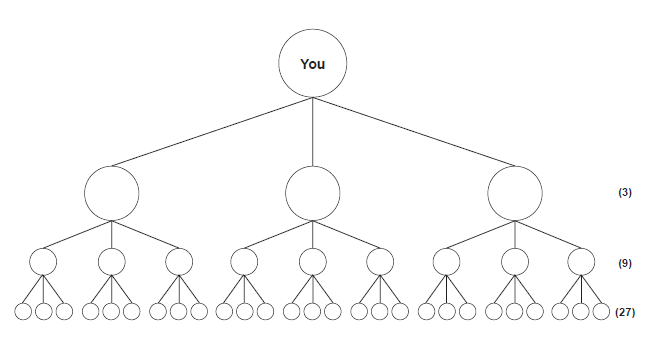
A 3 x 3 Matrix ( Source: ‘How to Build a Multi-level Money Machine’ by Randy Gage)
This plan limits a distributor’s network to a specific configuration.
E.g. In a 3 x 3 matrix MLM plan, every distributor in the company can sponsor only 3 people in their front level and can earn for volumes produced by 3 levels of distributors (3+9+27=39). Volumes produced by 4th level & beyond, are out of pay range of each distributor.
In a 3×9 matrix
3 x 3 = 9
9 x 3 = 27
27 x 3 = 81
81 x 3 = 243
243 x 3 = 729
729 X 3 = 2187
2187 x 3 = 6561
6561 x 3 = 19683
Total size of the matrix is 29523. That means you will be able to put 3 people in your front level and eligible earn commission on the basis of volume produced by your 9 levels i.e. your 19683 distributors.
Due to this structure, there is a limit to the no. of distributors that can be put in each level. Once all available positions are filled up in a particular level, new recruits are put in available positions in next levels. This is known as spillover.
Some companies fill up levels automatically. Some allow you to choose positions to place your new recruits among all available positions.
Matrix plan can be of advantage for a new distributor if he/she is sponsored by an active distributor and also placed under another active distributor. Increased support can help them to grow their business faster.
Matrix Plan Issues:
-
-
- No. of personal recruits you can put in your front level is limited. Once your front level is filled up, you have to put your new personal recruits at an available position in your network. If you have to put a personal recruit outside your matrix, you’ll not get benefitted from the volume generated by that recruit.
- You need to be very careful about filling your matrix. Inactive distributors in your Matrix can dramatically hurt your potential earning. Though in Matrix with higher width and/or depth, this risk is comparatively lower.
- Nature of Matrix plan allows putting your personal recruits under your downlines when your front level is filled up. That gives birth to wrong expectation in new distributors that they will become rich doing nothing, as their uplines will fill up their matrix with new recruits. In fact, some distributors lure people to join Matrix MLM plans with such false promises. Both results in inactive distributors and eventually quitters badmouthing the industry.
-
Normally, most companies that begin with a Matrix compensation plan, either move on to some other plan or add other plans to compensate for the limitations in Matrix plan.
Binary MLM Plan:
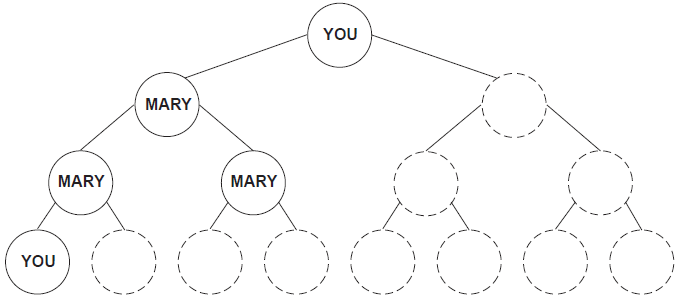
Think of Binary as 2 x Infinity Matrix plan.
That means, every distributor in the company can put only 2 people in their frontline and can earn for volumes generated by infinite levels of distributors. In a way, this overcomes the limitations of m X n Matrix plans, where your earning is limited by depth.
In Binary, your 2 sides are often called legs – right leg or left leg.
The leg, that gets benefits from automatic placements of new recruits not only from your personal effort but also from efforts of your upline (which is called spillover), is called power leg / outside leg / stronger leg.
The other leg is called profit leg/ income leg/ weaker leg where you won’t get any spillover from your uplines, and can only be filled with your personal recruits and theirs.
There are some unique features of Binary MLM plans:
-
-
- You are allowed to sponsor positions (or ‘income centers’) instead of sponsoring people. Income Centers are determined by volume. E.g. If 2500 INR volume is equal to an Income Center, someone entering with 7500 INR is taking three income centers.
- A sponsor can enter his her own organization.
- You only get paid on the volume that is in 1:1 or 1:2 /2:1 between your 2 sides.
-
Binary Plan Issues
Binary plans often are abused and attract a lot of legal troubles for various reasons.
-
-
- Very often people are encouraged to join with multiple income centers with the prospect of multiplying their income potential. Similarly, distributors with one side stronger than the other, are encouraged to buy new income centers on the weaker side to balance ratio and qualify for earning. Such acts turn a Binary MLM plan into an illegal Ponzi/Pyramid scheme.
- Balancing both legs, is not everyone’s cup of tea. When unmatched business volume in the stronger leg get ‘washed away’, the company and few distributors get rich, but most of the distributor doesn’t make a single paisa.
- This plan is perfect bait for hype. One can show off big cheque, company rewards, cars by buying multiple income centers overnight. Though he/she is getting paid from own money, prospects don’t know that and get lured to enter.
- Due to the Spillover effect like we’ve seen in Matrix plan, many new distributors either wrongly believe or are lured to join with false promise that their uplines will build one leg for them and they can become rich just by growing one leg. This unrealistic expectation results in wrong people entering this business.
-
Many legitimate MLM companies worldwide are working hard for years improving their Binary systems to prevent abuse.
2 important corrections:
-
-
- Prevention of extra volume getting ‘washed’.
- Restrictions regarding purchasing high volume to create more Income Centers.
-
The advantages of Binary system are that
-
-
- It’s very simple to understand and explain to others.
- If you can balance both legs, your income is not limited by depth.
-
StairStep BreakAway MLM Plan
This plan actually combines 2 plans:
-
-
- Stairstep plan: It pays based on your personal volume.
- Breakaway plan: You get paid for the people who ‘break away’ from your organization after reaching top rank and lead their own organization.
-
Things you should know about this plan:
-
-
- This is the oldest among all MLM compensation plans.
- Long established MLM companies have run this plan successfully for years.
- It’s a bit complicated.
- You can put all your personal recruits in your 1st level.
-
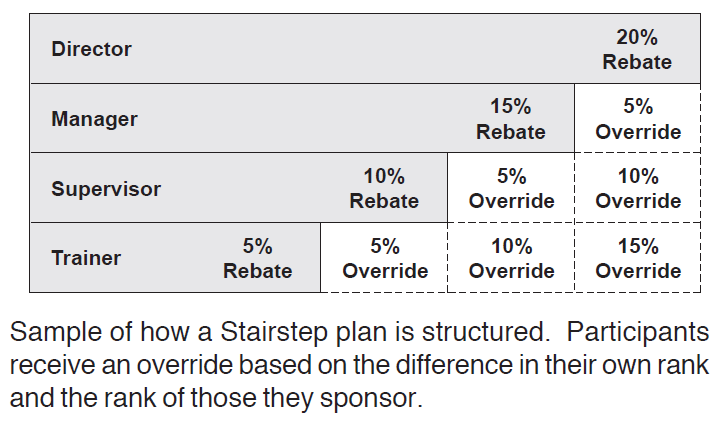
Like a staircase, each level represents a commission level. The lowest level represents lowest commission rate & the highest level represents the highest commission rate.
Depending on your company determined combination of your personal & group volume, you’ll be able to achieve different commission levels.
When you are at lowest level, you’ll earn commission at the lowest rate (5% in the above example) for your commissionable volume.
When you reach next level (Supervisor with 10% rebate in the above example), you earn 10% commission for your commissionable volume.
When you are at the supervisor level with 10% commission rate and one of your personal recruits is at trainer level with 5% commission rate. You’ll receive (10-5)=5% override for the commissionable volume generated by that recruit’s organization.
You will not receive any override commission for volume generated by a recruit’s organization if both of you are at same rank/level/step. But their group volume will count towards your group volume hence your level.
There is another way to explain it.
Say you are a Supervisor with Rebate SR & volume SV. If you don’t have any Trainer, then your commission is SR x SV.
But if you have a trainer in your organization with Rebate TR and volume TV, then their commission is TR x TV. And your commission is SR x SV – TR x TV = SR x (SV-TV) + (SR-TR)xTV. (SR-TR) is the override you are getting for your trainer’s volume TV. And for rest of your group volume (SV-TV), you are getting commission at your level rebate SR. Keep in mind that your level is being determined by SV.
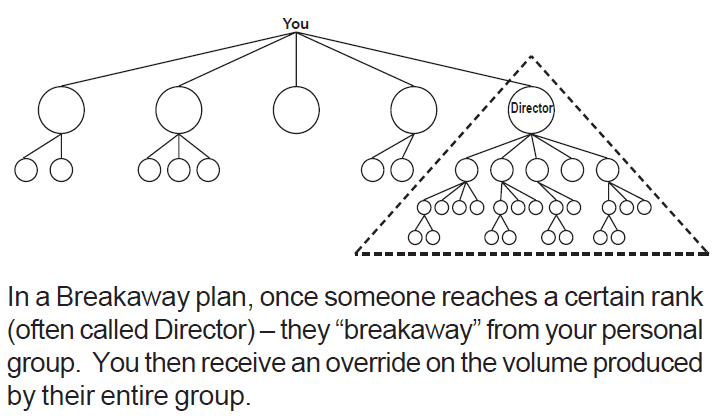
If one of your recruits reaches the highest level, they’ll breakaway from your organization and will form their own organization.
Their organization volume will no longer count to your organization volume but you’ll receive a flat override for their volume. Consider it as a residual income.
Extending from last example, say you are a Supervisor with Rebate SR & volume SV, have 1 Trainer with Rebate TR & volume TV, have 1 Director broken away with Rebate DR & volume DV. If breakaway override you are qualified for is DBR,
Then
-
-
- You are qualified as a supervisor with SV-DV, as volume of the organization that broke away, doesn’t count towards your volume.
- Income = SR x (SV-DV-TV)+ (SR-TR) x TV + DBR x DV
-
People often complain about this plan, because they can’t rip off other people in this plan. Consider an inactive distributor having a Director downline breaking away. That inactive distributor might not qualify for breakaway override as they’ve lost most of their group volume when that organization broke away.
But this is the right way to craft compensation plan. If you want to enjoy the benefits of depth in your network, you have to build the width. More people you personally sponsor & more products you personally retail, more you’ll earn in this system.
Stairstep Breakaway Plan Issues
This plan can also go bad with ‘top heavy’ or ‘bottom heavy’ approaches
-
-
- If the qualifying criteria to receive breakaway override is too high, 99% of distributors will not be able to qualify. Making the company and few at the top richer. Average distributors will not be able to make any significant money. Eventually, they’ll leave & badmouth this industry.
- On the other hand, if the plan over rewards new people, specially to attract distributors from other companies, eventually it will die. Why? Becuase you’ll not be able to pay top leaders what they deserve. Top leaders will eventually leave realizing that they can make way more money with same volume and organization in another company.
-
So balance is the key!
Unilevel MLM Plan
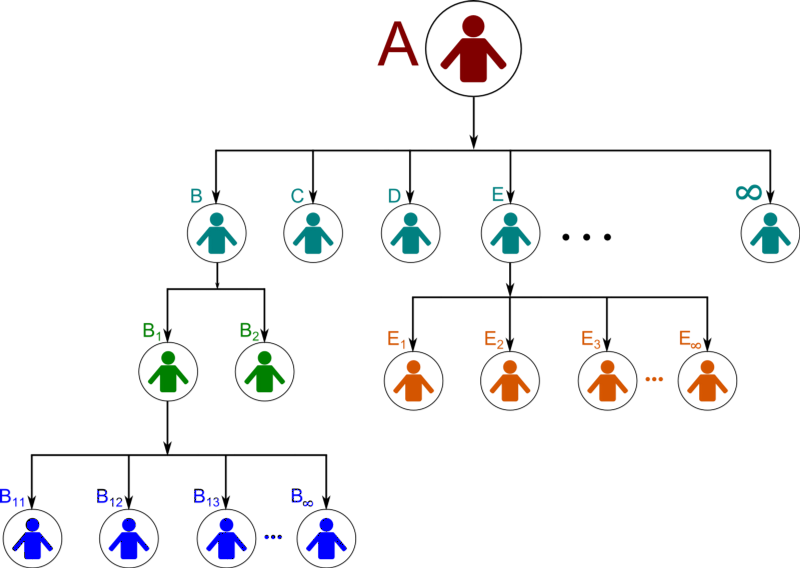
Source: Medium.com
Unilevel plan is very simple and easy to understand.
-
-
- You can put any number of personal recruits in your frontline. There is no width limitation.
- The limitation is in depth. You are eligible to earn for volumes generated by distributors from a certain number of levels below you.
- You can think of it an ‘infinity times certain depth’ matrix plan.
- There is no breakaway.
-
Unilevel plan issues
-
-
- New recruits often don’t get much support as their sponsors get busy in finding more recruits. That results in early discontinuation of distributors.
- You don’t get compensated for the volume generated by top leaders in your organization beyond your commissionable depth.
- ‘Bottom heavy’ unilevel plan is very attractive to new distributors, as they can start earning quickly. But as their organizations grow, they get disheartened due to the lack of proper earning potential.
-
Though these are the most popular and fundamental MLM plans, now a days companies are coming up with many hybrid plans combining elements of different elements of the plans mentioned above.
If these hybrid plans actually make up for the limitations in the original plans, that’s good. But often, new MLM plans don’t survive the test of time.
If you are going to start your own MLM company, I’ll recommend you to get expert advise in crafting your compensation plan.
-
-
- Keep it simple.
- Keep it win/win/win/win for your customers/new distributors/top leaders/your company.
-
If you are planning to join an MLM company as a distributor, I will recommend you to do proper research about the compensation plan before joining.
-
-
- Is it simple to understand and explain?
- Is this plan time-tested or new sensation?
- Is it fair both for new distributors as well as top leaders?
-
To conclude this article, I want you to understand that MLM / Network Marketing / Direct Selling is a booming industry and India is going to see an exponential growth in coming years.
Joining as a distributor in a legitimate MLM company, whose products you really find useful & shareworthy, is a great way to start a business at least possible startup cost & least headache. If you do due diligence, get yourself educated about this industry, work 5-7 hours/week for 5-10 years with a good MLM company, possibilities are limitless. Even if you keep the money aside, what you learn doing the journey is priceless and can help you to transform your personal and professional life.
On the other hand, if you get trapped by ‘get rich quick’ scams promising you ‘easy money’ ‘no selling’ etc etc you not only put yourself at risk of losing your reputation, but also get arrested for participating in illegal pyramid scheme.
If you want to start your MLM company, think twice or thrice or maybe a million times. If anyone (generally the MLM software providers) is trying to convince you that you can make a lot of money by starting your MLM company and they are not telling you the humongous responsibilities associated with running an MLM company, trust me they are not your well-wisher.
Growing a business as an MLM distributor is one of the simplest ways to run a business, as the MLM company is taking care of everything – manufacturing, shipping, support, payout & a lot more.
But running an MLM company is not everyone’s cup of tea. Most time-tested MLM companies have more distributors than the total number of employees in biggest corporations (outside MLM industry). It’s not easy to train, manage & be accountable for so many unqualified associates (anyone without any background in sales, marketing or business can join as a distributor in your MLM company) of your company. Battling legal troubles arising due to the misconducts of your distributors or just lack of awareness about this industry in law enforcement isn’t easy either.
So get into this bandwagon only if you know what’s coming and you are confident that you have what it takes to successfully run an MLM company for long term.
That’s all for now. Let me know in the comments if you found this article useful. Enlighten me if I missed including some important information, I’ll update the article accordingly. Have a query? Drop me a message on Facebook.
 Serato DJ Crack 2025Serato DJ PRO Crack
Serato DJ Crack 2025Serato DJ PRO Crack


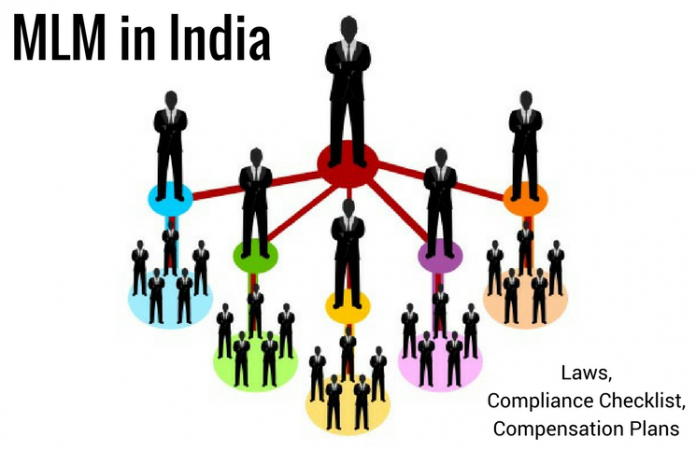









 Allow notifications
Allow notifications




That is the perfect example. Great article.
The legal structure for MLM in India is still very weak. Our law and policymakers are yet to understand this industry properly and come up with proper laws.
The above recommendation from Strategy India is actually from the experiences of the top players from the Direct Selling Industry from all over India. Follow Global Industry educators like Randy Gage ( Refer to his book ‘Direct Selling Success’ & FB Page ‘Direct Selling Daily’) and they’ll tell you the same, if not higher investment requirements.
Anyone telling you that you can start and run an MLM / Direct Selling company with less investment is simply misguiding you. Anyone can start an MLM and even can build a huge network selling trash fooling people. But to start, grow and sustain a legitimate Direct Selling company like Amway etc, you need a whole different level of preparation in terms of investment and experience.
That is the perfect example of how to work mlm business. Good article!
nice post
Read all about multi level marketing in India here You can also consult with a legal advisor at link for resolving your concern ASAP.
How to Structure a Legal MLM in India [Laws, Compliance Checklist, Compensation Plans]
[…]To be sure you get the most out of the time you spend network marketing, take a look at how much earnings the assorted activities you do produce.[…]
“Minimum net worth of the Promoters of the company should be INR 50,00,000 (Fifty lac Indian rupees) and its paid-up capital should be a minimum of INR 5,00,000 (Five lac Indian rupees)”
In which law it is mention? i couldn’t find it anywhere. can you please suggest this. Thanks in advance.
I also had seen this clause as a law, it is actually a recommendation from a legal liaison consulting company website. People misconceiving its as a law.